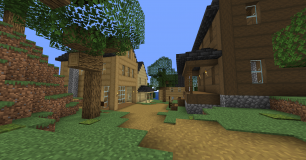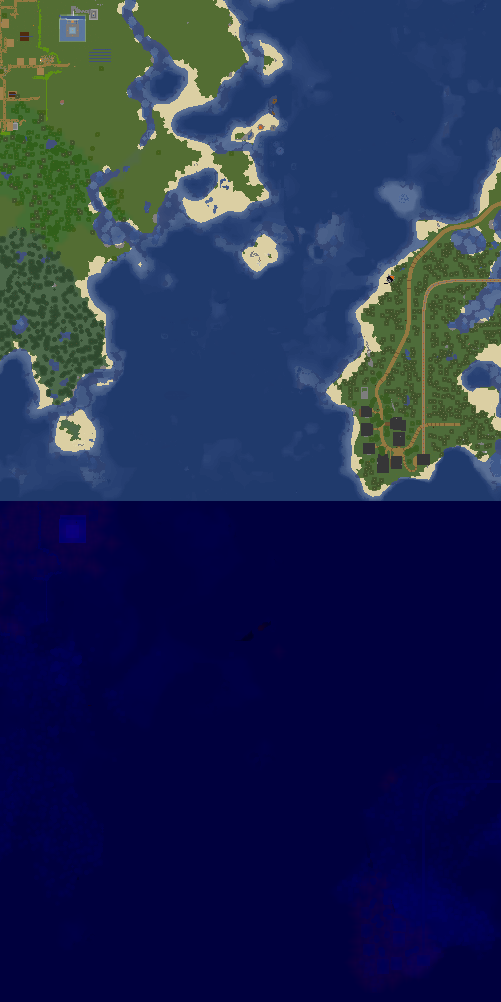Blues Beach
From Dogcraft Wiki
| Blues Beach | |
|---|---|
| Survival 4 Husky | |
Blues Beach village center | |
| Settlement | |
| World | Survival 4 (Husky) |
| Founded | October 2021 |
| Mayor(s) | _Shako |
| Contributors | _Shako |
| Location | X= -3100 Y= 72 Z= 2950 |
| Transport | Survival Railway Network Southwest Branch Line |
Blues Beach was a village on the Survival 4 Husky world of the Dogcraft Server. It was planned and built by  _Shako, who was the only resident. Blues Beach was located on the end of a peninsula into a large lake across from PinksVille and Lotus. It was 1 kilometer southwest of Vitruvius. It could be accessed by the Road and Horse Network using Blues Beach Road from Vitruvius Road or Spoons Neck Road from Lotus Isthmus Road, by the Survival Railway Network from Vitruvius, or by /phome Blues Beach.
_Shako, who was the only resident. Blues Beach was located on the end of a peninsula into a large lake across from PinksVille and Lotus. It was 1 kilometer southwest of Vitruvius. It could be accessed by the Road and Horse Network using Blues Beach Road from Vitruvius Road or Spoons Neck Road from Lotus Isthmus Road, by the Survival Railway Network from Vitruvius, or by /phome Blues Beach.
About
A number of inspirations led  _Shako to build Blues Beach. One was reading an article about Times Beach, Missouri, a riverside vacation community that was demolished in the 1980s after being contaminated with toxic oil. This reminded
_Shako to build Blues Beach. One was reading an article about Times Beach, Missouri, a riverside vacation community that was demolished in the 1980s after being contaminated with toxic oil. This reminded  _Shako of Briny Beach, a dull and gray beachside in A Series of Unfortunate Events. Thirdly, the name "Blues Beach" came directly from Blues Beach, West Virginia, a riverside unincorporated community (no municipal government, under county-level jurisdiction) consisting mostly of vacation houses along the South Branch of the Potomac River.
_Shako of Briny Beach, a dull and gray beachside in A Series of Unfortunate Events. Thirdly, the name "Blues Beach" came directly from Blues Beach, West Virginia, a riverside unincorporated community (no municipal government, under county-level jurisdiction) consisting mostly of vacation houses along the South Branch of the Potomac River.  _Shako, who is from West Virginia, lives relatively near Blues Beach and has visited in person. Its name was thought by
_Shako, who is from West Virginia, lives relatively near Blues Beach and has visited in person. Its name was thought by  _Shako to have a connotation similar to "Briny Beach," having a dismal sound from the word "blues" referring to sadness.
_Shako to have a connotation similar to "Briny Beach," having a dismal sound from the word "blues" referring to sadness.
With these factors in mind, the idea for Blues Beach on Dogcraft was to be a small, village-like beachside community with shack-like and rustic houses, having a vacation-home or economically depressed appearance that was simultaneously charming and unexciting.
Architecture
The structures in Blues Beach were vernacular (folk) houses, mostly taking forms found in Appalachia such as the I-house or coal company houses such as those in Cass, West Virginia. The houses were built with horizontal stripped logs to emulate clapboard siding and had small windows spaced apart. The interiors were fully built with an average of five or six rooms inside. The only buildings with commercial intent were a small shop in the center of the village, with an apartment above, and the Survival Railway Network station, which had Tudor-inspired style that evoked late-19th-century railroad stations while fitting the cottage-like theme of the village.
Gallery
| ||||||||||||||












